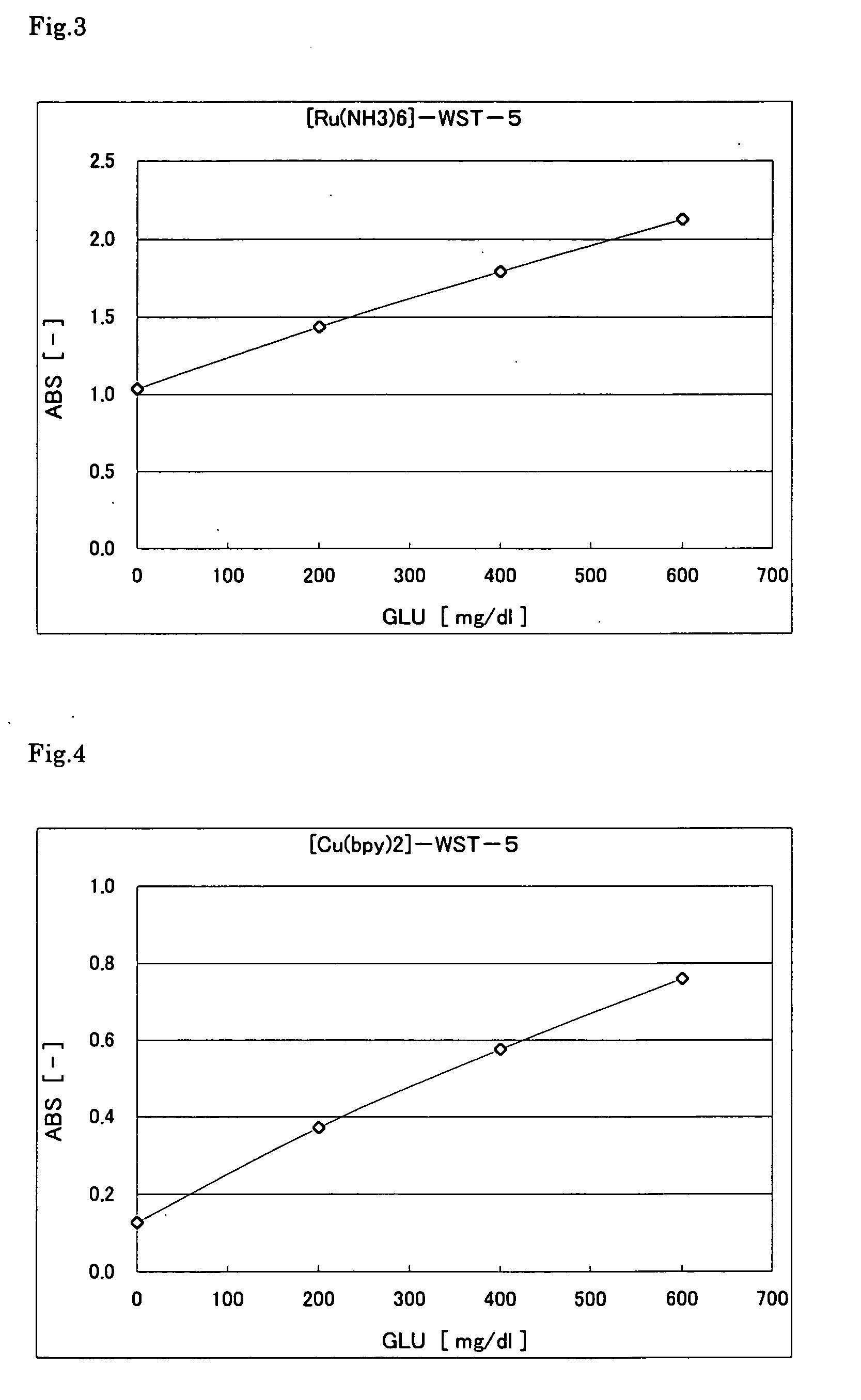Method of colorimetry and reagent for use therein
a colorimetry and reagent technology, applied in the field of colorimetry, can solve the problems of short measuring time and short time between the enzyme reaction and the color production reaction, and achieve the effect of short time analysis
- Summary
- Abstract
- Description
- Claims
- Application Information
AI Technical Summary
Benefits of technology
Problems solved by technology
Method used
Image
Examples
example 1
[0100] An osmium complex [OsCl(Him)(dmbpy)2] was synthesized. First, 2.00 g (4.56 mmol) of (NH.sub.4).sub.2[OsCl.sub.6] and 1.68 g (9.11 mmol) of dimethylbipyridyl (dmbpy) were refluxed in ethylene glycol (60 ml) for 1 hour under a nitrogen stream. After cooling to room temperature, 1M sodium hydrosulfite solution (120 ml) was added for 30 minutes, followed by cooling in an ice bath for 30 minutes. The precipitates thus produced were filtered under reduced pressure and sufficiently washed with water (500 to 1000 ml). Further, the precipitates were washed two times with diethyl ether, and then dried under reduced pressure. Thus, 1.5 to 1.7 g of [OSCl.sub.2(dmbpy).sub.2] was obtained. Next, 1.56 g (2.60 mmol) of the resultant [OSCl.sub.2(dmbpy).sub.2] and 0.36 g (5.2 mmol) of imidazole (Him) were refluxed in a water / methanol mixed solvent (50 ml) for 2 hours under a nitrogen stream. After cooling to room temperature, a saturated NaCl solution (300 ml) was added. The precipitates thus ...
example 2
[0102] The following reagent solution including the osmium complex was prepared. First, 5 .mu.l of glucose (GLU) solution with different concentrations (0, 200, 400, 600 mg / 100 ml) was placed in a microcell (made of polymethacrylate) having an optical path length of 10 mm. Then, 1000 .mu.l of the reagent solution was added, and the absorbance was immediately measured at a wavelength of 600 nm. FIG. 2 shows the results. The graph indicates that the color was produced in accordance with the glucose concentration. Since the reaction was performed rapidly, it took substantially only 1 second before the substrate was consumed completely.
3 Reagent solution composition WST-5 (DOJINDO LABORATORIES) 0.5 mM [OsCl(Him)(dmbpy).sub.2]Cl.su-b.2 0.1 mM PIPES (pH 7.0) 40 mM PQQGDH 200 U / ml
example 3
[0103] The following reagent solution including a ruthenium complex was prepared. First, 5 l of glucose (GLU) solution with different concentrations (0, 200, 400, 600 mg / 100 ml) was placed in a microcell (made of polymethacrylate) having an optical path length of 10 mm. Then, 1000 .mu.l of the reagent solution was added, and the absorbance was immediately measured at a wavelength of 600 nm. FIG. 3 shows the results. The graph indicates that the color was produced in accordance with the glucose concentration. Since the reaction was performed rapidly, it took substantially only 2 seconds before the substrate was consumed completely.
4 Reagent solution composition WST-5 (DOJINDO LABORATORIES) 0.5 mM [Ru(NH.sub.3).sub.6]Cl.sub.3 (Aldrich) 10 mM PIPES (pH 7.0) 40 mM PQQGDH 200 U / ml
PUM
| Property | Measurement | Unit |
|---|---|---|
| Volume | aaaaa | aaaaa |
| Volume | aaaaa | aaaaa |
| Volume | aaaaa | aaaaa |
Abstract
Description
Claims
Application Information
 Login to View More
Login to View More - R&D
- Intellectual Property
- Life Sciences
- Materials
- Tech Scout
- Unparalleled Data Quality
- Higher Quality Content
- 60% Fewer Hallucinations
Browse by: Latest US Patents, China's latest patents, Technical Efficacy Thesaurus, Application Domain, Technology Topic, Popular Technical Reports.
© 2025 PatSnap. All rights reserved.Legal|Privacy policy|Modern Slavery Act Transparency Statement|Sitemap|About US| Contact US: help@patsnap.com



